Conditionally removable prosthetics
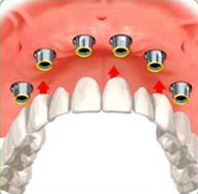
Removable prosthetics - prosthetics, in which one or more teeth are replaced.
Why is it conditionally removable?
The patient will not be able to remove such a prosthesis on his own, and the doctor, if necessary, can remove the design and replace it with another.
This design can be mounted:
- To the abutment teeth with metal legs.
- The supporting parts of the prosthesis are glued to the tooth, or fixed with cement.
- Using micro locks.
How is the prosthesis arranged?
Laminar dentures, which are usually used with conditionally removable prosthetics, consist of:
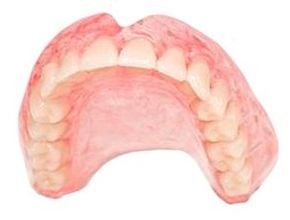
- The base of the prosthesis (artificial gum).
- Artificial teeth.
- Laminar dentures are classified as removable structures, but if they are fixed on implants, then they can be classified as conditionally removable.
- Conditionally removable dentures on implants are fixed with an artificial plastic gum, so for reliability they are mounted on cement or on special screws. This prosthesis can only be removed by a doctor.
- The clasp prosthesis can be fixed both on the abutment teeth with hooks and on implants (metal roots). The patient can remove such a prosthesis on his own.
Artificial teeth in the construction are made of ceramic or plastic.
Kinds
Conditionally removable prostheses can be:
- With a cermet crown.
- With a metal-plastic crown.
- No gingival mask.
- With gum mask.
Types of conditionally removable prosthetics:
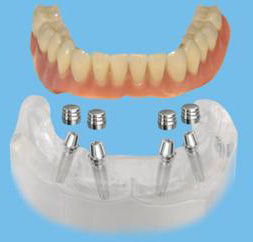
- Conditionally - removable prosthetics on implants. Most often used to restore a whole dentition. This requires the installation of only four implants, which are installed in the front of the jaw. This prosthetics option is suitable for patients who cannot afford the installation of expensive bridges. Such a prosthesis does not move in the mouth, does not rub the gums, and is firmly fixed.
- Prosthetics by gluing the prosthesis to the abutment teeth or lowering the structure into special grooves of the abutment teeth with additional fixation with cementing material.
Types of attachment of prostheses to implants:
- Spherical fastening - a lock in the form of a ball. Inside the structure there are recesses that match the shape of the abutment mount, but have a slightly smaller size. This type of fastening is less reliable, since spherical supports can often fail.
- Beam mount. The beam is mounted inside a removable structure. When connecting the prosthesis to the implant, it clicks on the implant. This ensures reliable fixation of the structure in the oral cavity.
Which ones are still better?
- Conditionally removable constructions are an alternative to permanent and removable types of prosthetics.
- Conditionally - a removable denture differs from a permanent one in that its installation is cheaper even when restoring a whole dentition.
- Unlike removable dentures, the conditionally removable design is more comfortable for the patient, because it holds fast enough, it does not need to be removed.
- Even if conditionally removable prosthetics is performed very efficiently, dentures will last no more than a year. Usually, after a year, the mounts break.
Video: “Prosthetics with complete loss of teeth”
Indications
- The absence of one or more teeth in a row.
- Complete lack of teeth.
- Restoration of teeth on the upper or lower jaw.
- Inability to install permanent structures.
- Lack of supporting teeth in a row.
- The inability to use removable dental structures.
Contraindications
- Acute inflammatory processes in the oral cavity.
- Pregnancy.
- The period after radiation therapy.
- Addiction.
- Mental illness.
- Allergic reactions to the material of which the structures are made.
- Allergy to drugs for anesthesia.
- Exacerbations of chronic diseases.
- Reception of antitumor and anti-clotting drugs.
Pros and cons
Among the advantages of such designs can be noted:
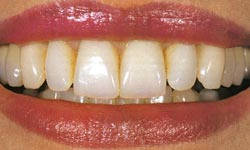
- Optimum load distribution on the denture. Due to this, the structure is resistant to wear and tear, the service life and functionality are extended.
- Comfort and lightness when using the design.
- Good fixation of the prosthesis in the mouth.
- If necessary, the structure can be removed.
- There is no de-cementing.
- The absence of visible parts of the prosthesis in the oral cavity.
- Deformation of the dentition is prevented.
- Completely replaces the function of missing teeth.
- No need for additional design hygiene.
- Low cost of the prosthesis.
Among the disadvantages of conditionally removable prosthetics are:
- The complexity of the work spent on the manufacture and installation of structures for conditionally removable prosthetics.
- The increase in the cost of the prosthesis, due to the need to use additional parts of dental implants.
- In some cases, the location of the implant screws does not provide the desired aesthetic effect.
- Such constructions require “maintenance” associated with the replacement of seals, tightening and replacing screws and implant heads.
Care
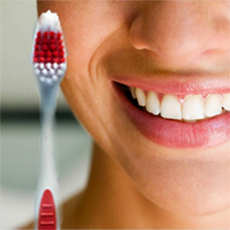
- Caring for a semi-removable structure is quite simple.
- In the morning and before going to bed, you should clean your oral cavity and artificial teeth with a brush and toothpaste.
- Especially carefully it is necessary to clean the interdental spaces and inaccessible places between the gum and the prosthesis.
- It is necessary to rinse the oral cavity every time after eating.
- At least twice a year, undergo an examination with a dentist who will conduct better oral hygiene and remove the structure for cleaning.
- Proper dental and prosthetic care can significantly prolong the life of the structure.
Prices for conditionally removable dentures
| Type of prosthetics | Cost (in rubles) |
| Ceramic-metal crown with support on the implant | 19000 |
| Removable implant-supported design with plastic attachments | 72000 |
| Implant-based removable denture | 80000 |
FAQ
- Question: Do conditionally removable dentures put on one tooth?
Answer: Conditionally - removable dentures are recommended, as a rule, in the absence of one chewing tooth.
- Question: I have completely no teeth. Can I put dentures on mini implants?
Answer: Mini implants can be placed as a support for a removable denture. For good fixation, 4 to 6 implants are needed.
- Question: Can mini-implants be placed on the upper jaw if there are no posterior upper molars?
Answer: Mini implants are installed to create support for a conditionally removable prosthesis. Separate crowns cannot be placed on mini implants.
Photos before and after conditionally removable prosthetics
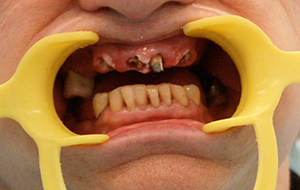 |
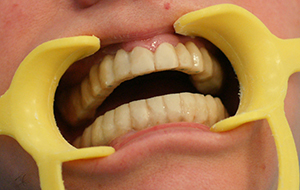 |
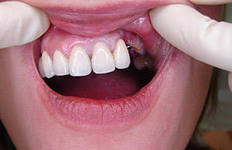 |
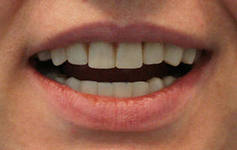 |
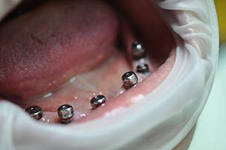 |
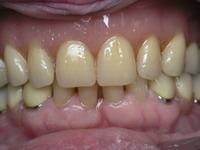 |
